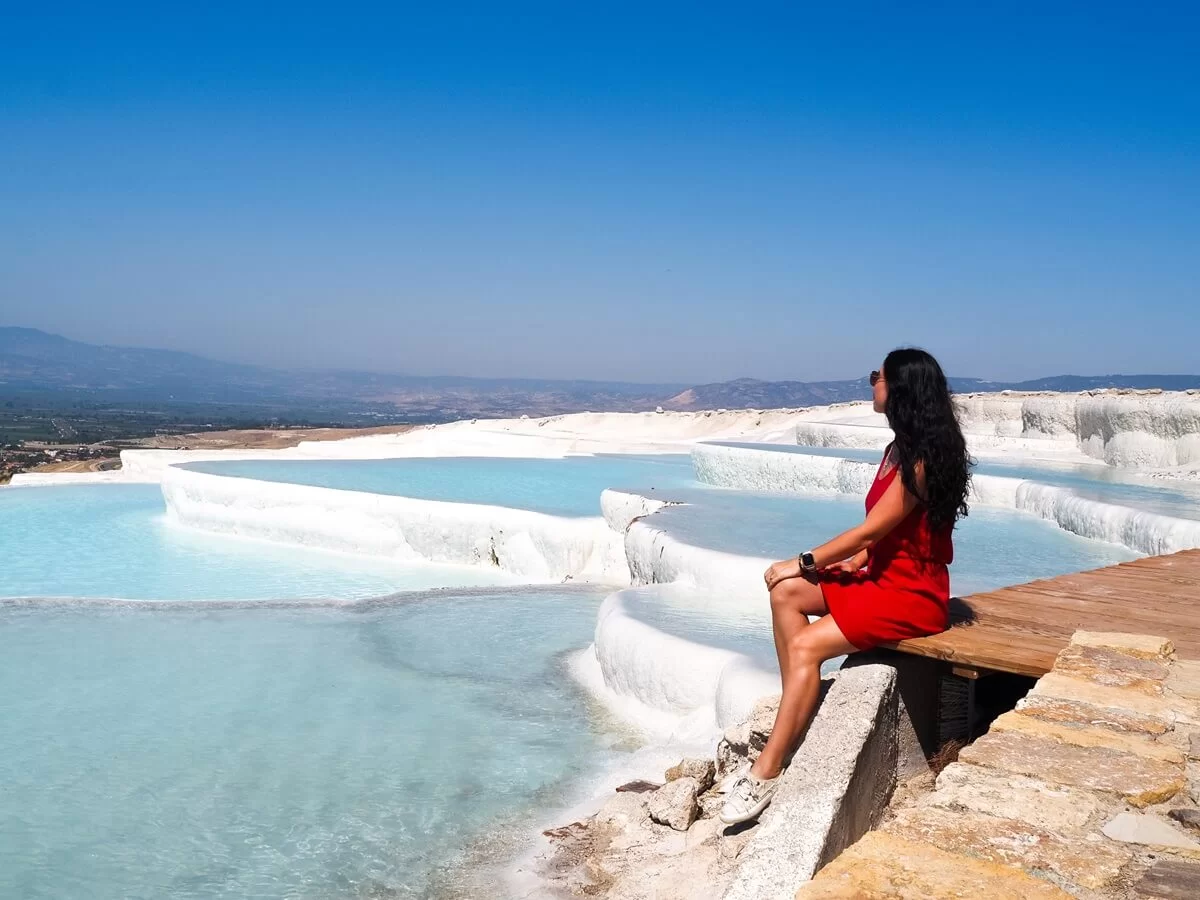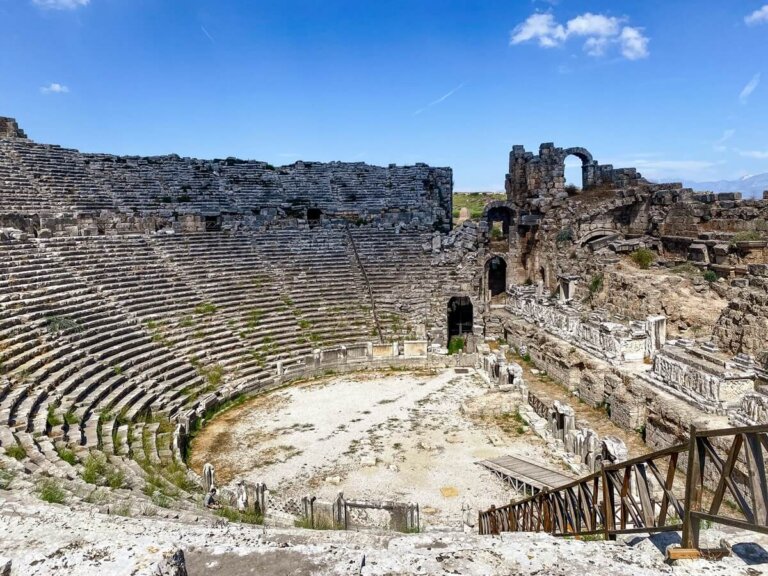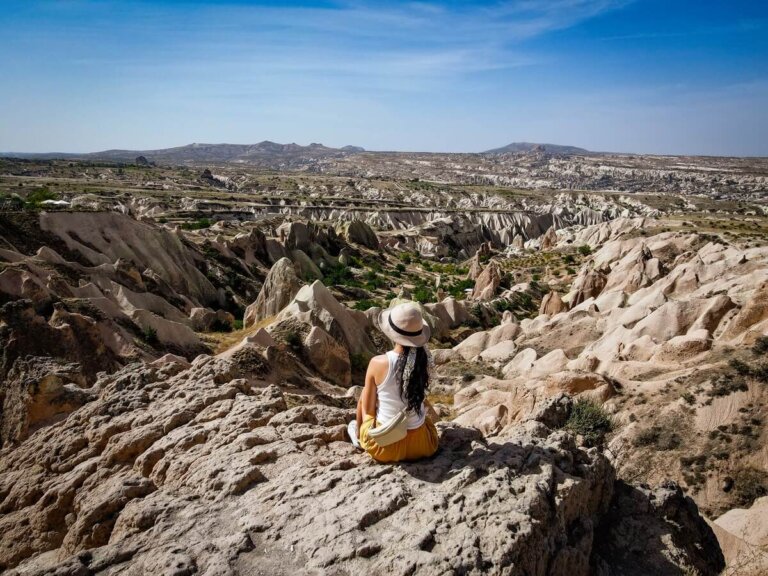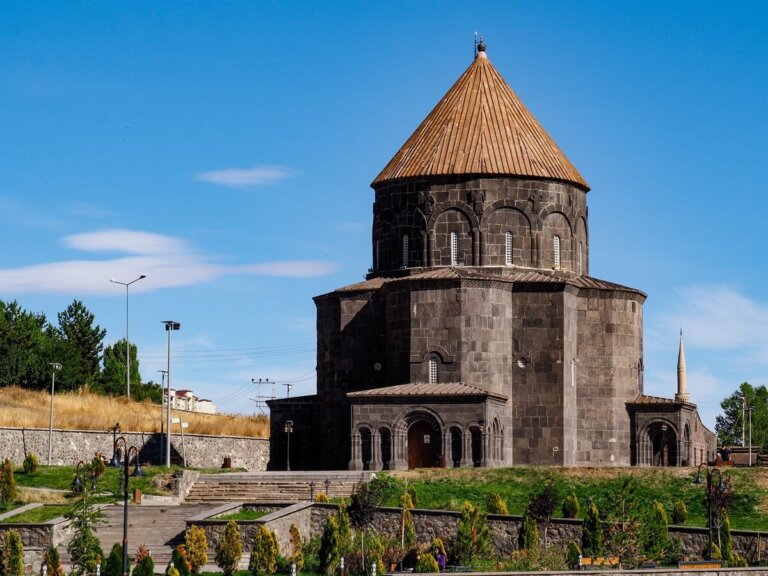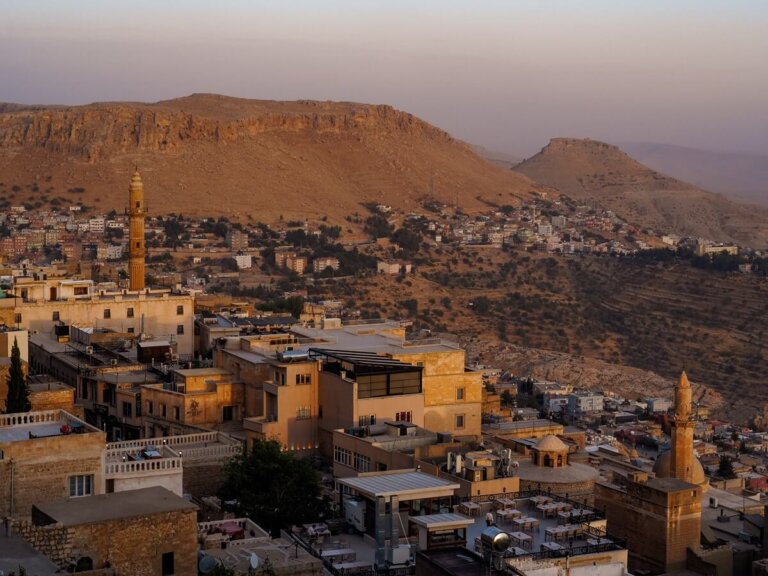One Day in Pamukkale and Hierapolis, Turkey (Türkiye)
If you’re currently planning your trip to Turkey (Türkiye), then we’ll bet that a visit to the beautiful travertine pools of Pamukkale is on your bucket list. You’ve probably seen plenty of photos of the white pools, filled with pristine blue water, all over the Internet. However, did you also know that there’s way more to do in Pamukkale than just the thermal pools? There’s actually an entire ancient city, called Hierapolis, behind the picturesque pools, so you won’t have any trouble spending an entire day at the site.
In this post, we’ll share everything you need to know about visiting Pamukkale’s travertine pools in Turkey (Türkiye), including how to get there, the best time to visit, where to stay and what else there is to do there.
Disclosure: This post may contain affiliate links, which means we may receive a small commission if you click a link and purchase something. Clicking these links won’t cost you anything, but it will help us to keep this site up and running! Learn more about our affiliate policy.
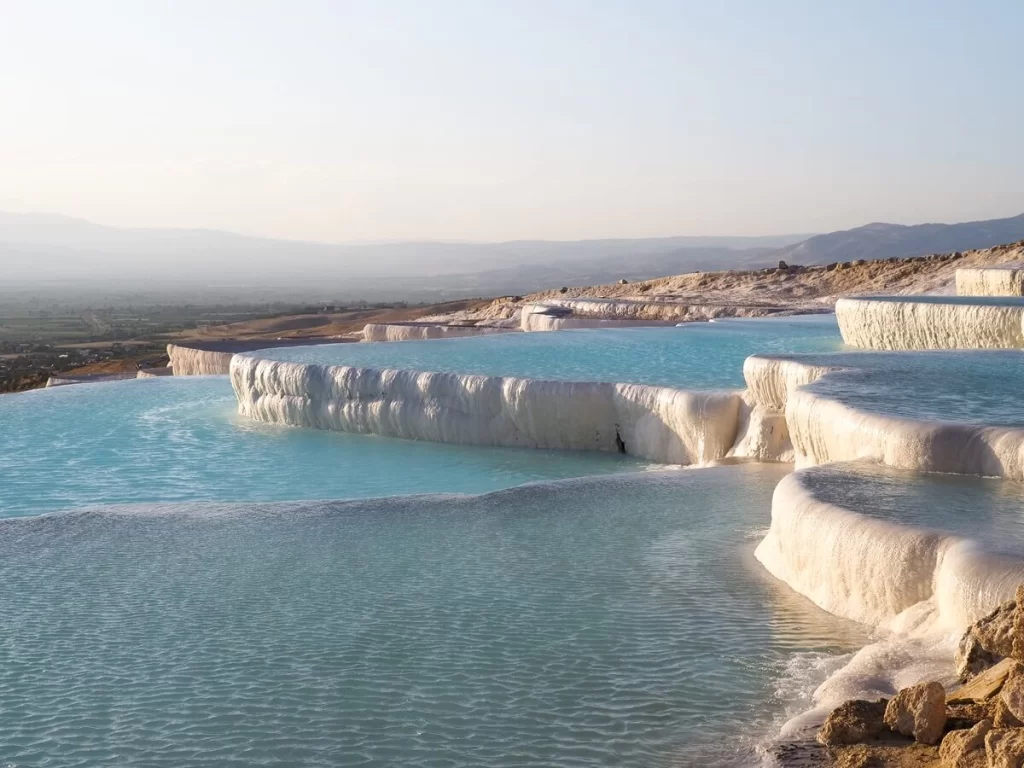
Introducing Pamukkale, Turkey (Türkiye)
Pamukkale is located in the southwest of Turkey (Türkiye), in the Aegean region. The closest main city is Denizli, about 16km south of the town. Pamukkale translates to ‘Cotton Castle’ in Turkish, and the site consists of several terraced pools, mineral forests, and petrified waterfalls.
The water is rich in carbonate, minerals, and calcium deposits, which creates the beautiful blue colour. The minerals harden as the water flows down the cliff face, creating the white pools, called travertines, you see today.
These thermal pools were discovered in the 2nd century BC by the ancient Greeks. They built a city around them, known as Hierapolis. Although the city was rebuilt multiple times in the years after, it remained an important place during the Roman and Byzantine periods, and was a centre for Christianity in the region. Hierapolis was completely abandoned in the 14th century.
Today, both Pamukkale and the ancient city of Hierapolis are a UNESCO World Heritage Site.
Did you know? There are other places in the world with similar travertine formations, such as Hierve el Agua in Mexico.
Our Top Travel Resources to Visit Pammukkale
- 🛏️ Find your accommodations with Booking.com
- 🎫 Book an organised tour in Pamukkale with GetYourGuide
- 🛡️Don’t forget to buy travel insurance via SafetyWing

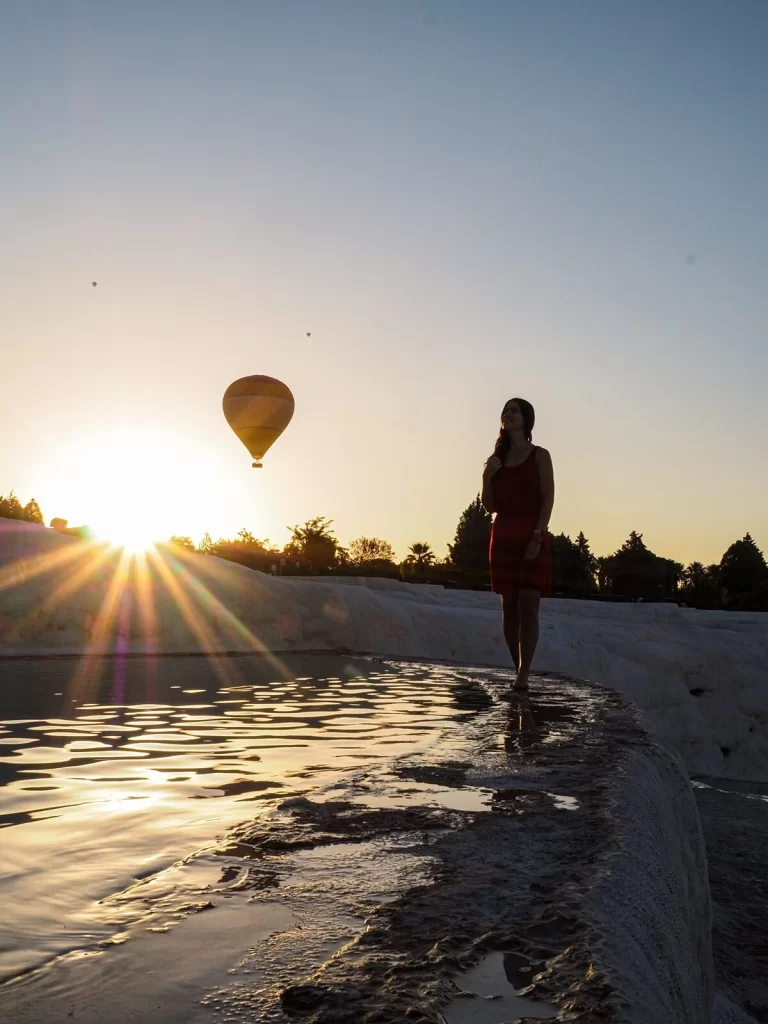
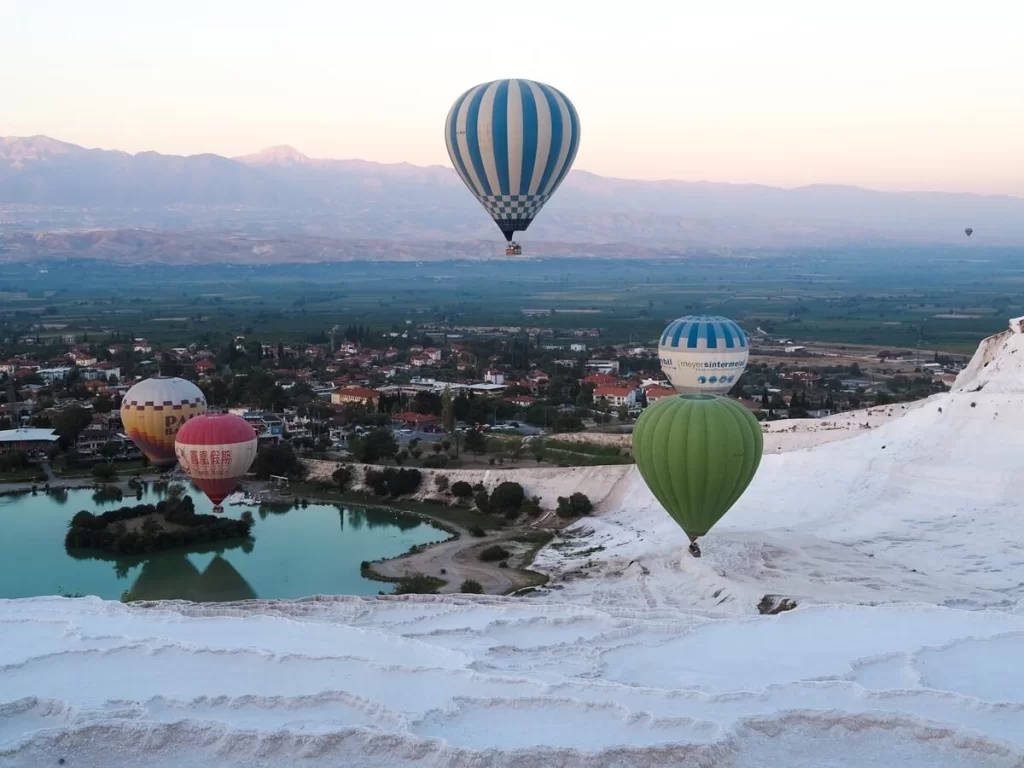
Things to Do in Pamukkale and Hierapolis in One Day
1. Go on a Sunrise Hot Air Balloon Ride
I think we can all agree that the ultimate place to go on a hot air balloon flight in Turkey (Türkiye) is in Cappadocia. However, that doesn’t mean there aren’t other beautiful places in the country to go on this kind of adventure. Pamukkale’s unique landscape provides a fantastic backdrop for hot air balloon flights too. Plus, it’s generally more affordable than in Cappadocia.
You can sign up for a morning balloon ride anywhere in town. We also noticed that some day tours include an optional hot air balloon flight experience. However, be prepared for a very early start, as most of these tours leave around 4AM. Book a hot air balloon flight experience here.
Top Tip. Watching the hot air balloons during sunrise from Pamukkale is just as amazing. You can always arrive at the site for opening time and enjoy the striking landscape, with the additional bonus of the hot air balloons in the background. We had a similar experience at the Teotihuacan Pyramids in Mexico and it was fantastic.
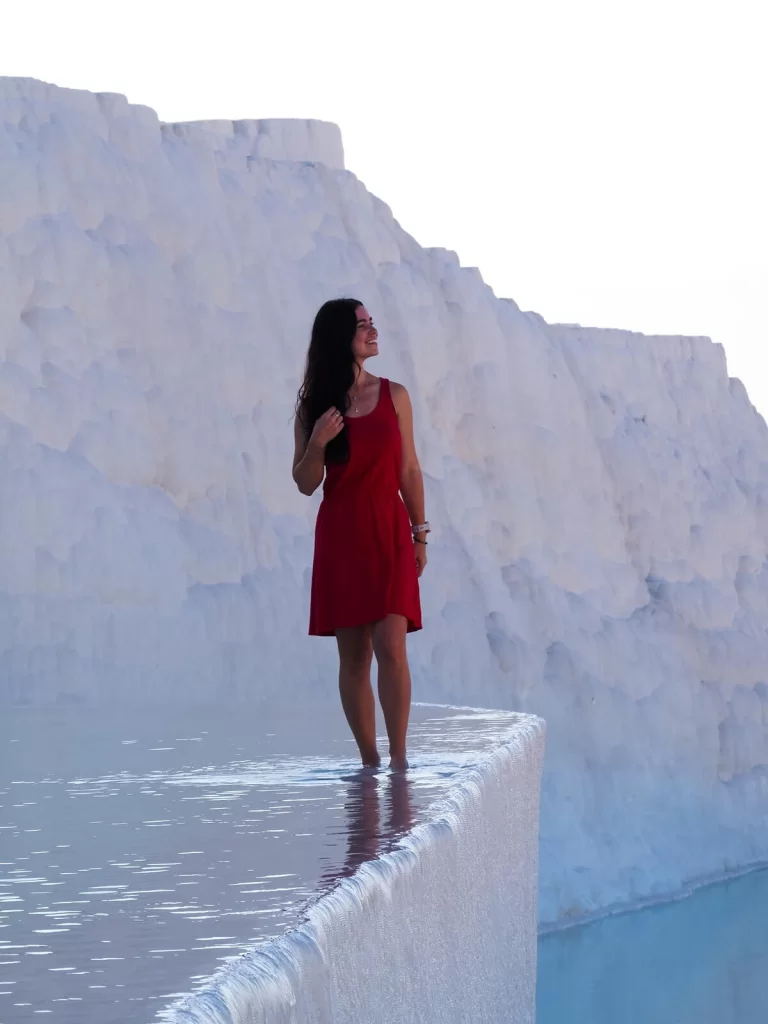
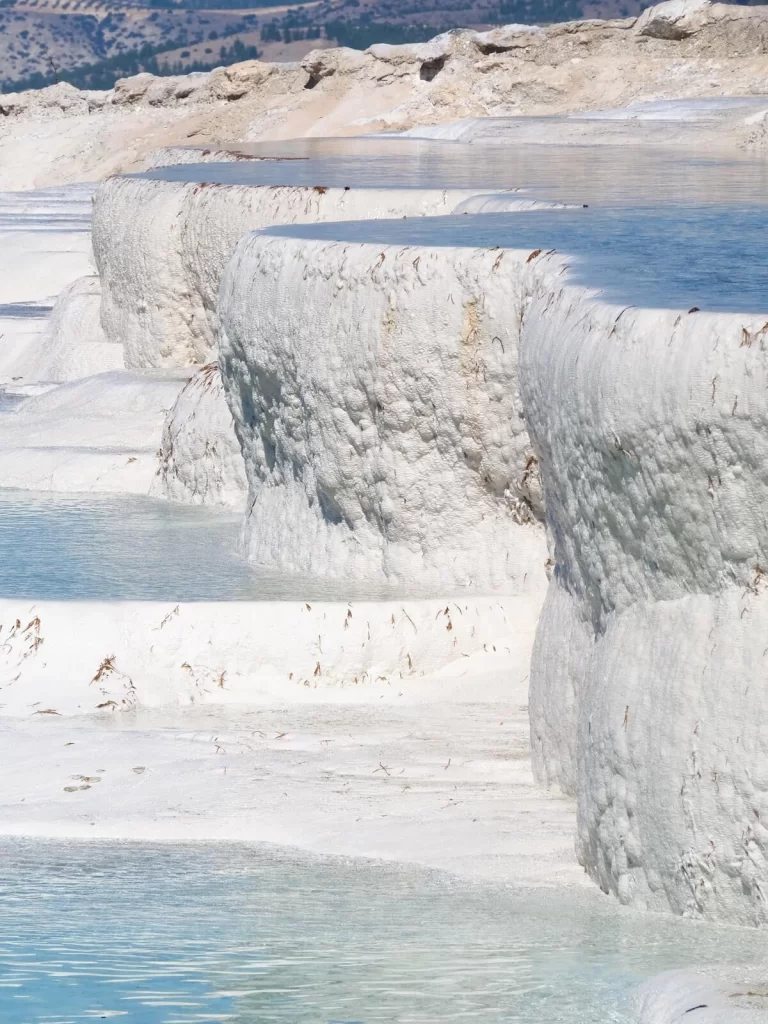
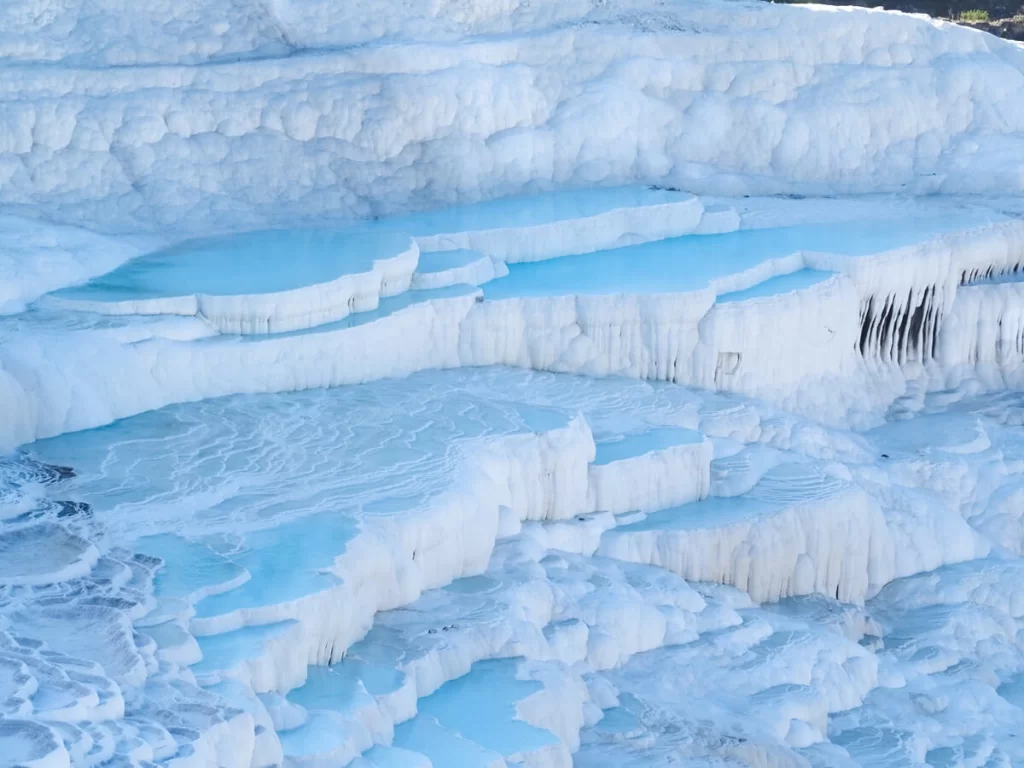
2. Enjoy Pamukkale Travertine Pools
Of course, the main reason for visiting Pamukkale is to see the travertine pools. As mentioned above, the ancient Greeks discovered them around the 2nd century BC, so they’ve been a popular attraction for, quite literally, millennia now.
The travertine pools, overlooking the plain of Curuksu, don’t just offer an extraordinary landscape to look at. Thanks to the mineral-rich water, the pools have been used as a wellness treatment to cure certain diseases.
As you can imagine, there are also plenty of legends surrounding these pools. One of the most popular tales is that an ugly girl became suicidal and threw herself off the cliffs but, after accidentally falling into the pools, became beautiful and desired.
Note. You’ll need to take your shoes off to walk along the travertines. There are way more pools than what you see online. However, many of them are actually dried out. We saw that workers were diverting the water in the morning to fill up some of the most accessible pools. It’s still better to come early in the morning though, because by late morning the pools will be filled with more people than water. You might want to come back in the late afternoon, when some of the big groups have already left.

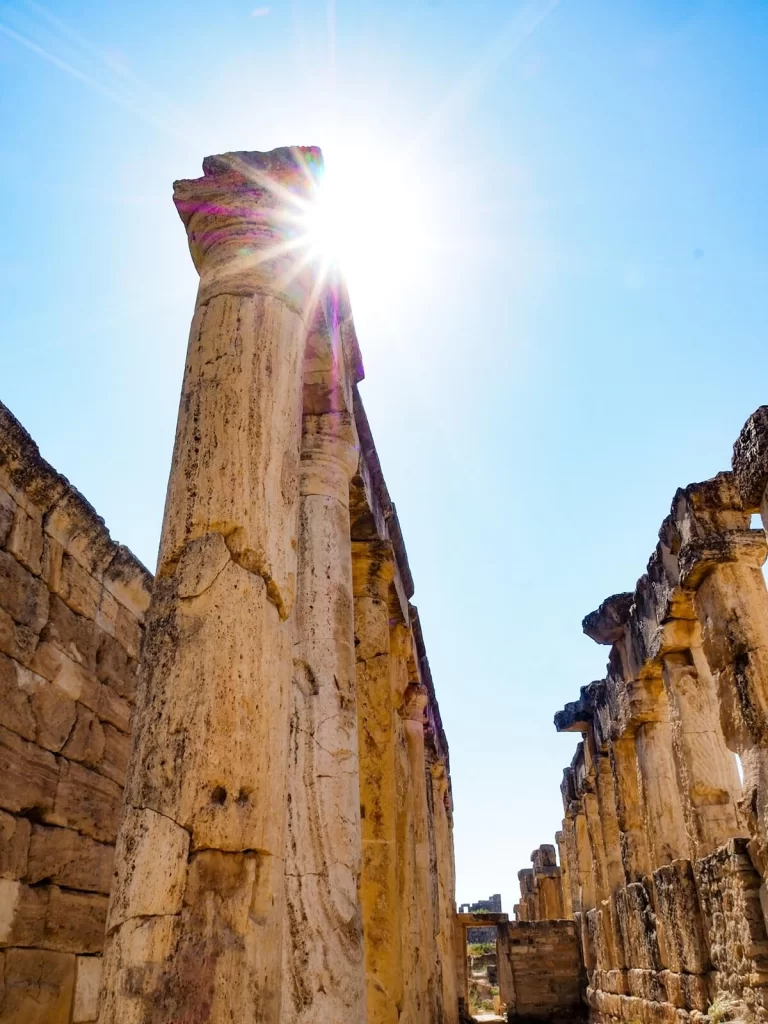

3. Walk Around Hierapolis Ancient City
Your visit to Pamukkale wouldn’t be complete without walking around Hierapolis Ancient City. It was founded by Eumenes II, the King of Bergama, in the 2nd century BC, during the Hellenistic period.
Since the city was located in an earthquake prone area, Hierapolis was continuously being destroyed and rebuilt to repair the damages. A lot of the buildings that are still standing today were actually constructed after a devastating earthquake in 60 AD. Although the site was rebuilt, its appearance became more that of a typical Roman city.
Hierapolis remained an important city during the Byzantine period as well. During this time, Christianity was on the rise, and it was believed that Philip the Apostle spent his last years here.
In the 7th century, Hierapolis was once again destroyed by an earthquake. In the 13th century, the city was under the control of the Seljuks, before it was abandoned again in the 14th century. The first excavations of Hierapolis weren’t until 1887.
Some of the landmarks you don’t want to miss are the main street, the gates (Frontinus Gate, North Byzantine Gate, Gate of Domitian), the Necropolis, the Roman baths, the Martyrium, the Nymphaeum, and the Temple of Apollo.
Fancy visiting other ancient cities in Türkiye? If so, then check out some of our other blog posts:
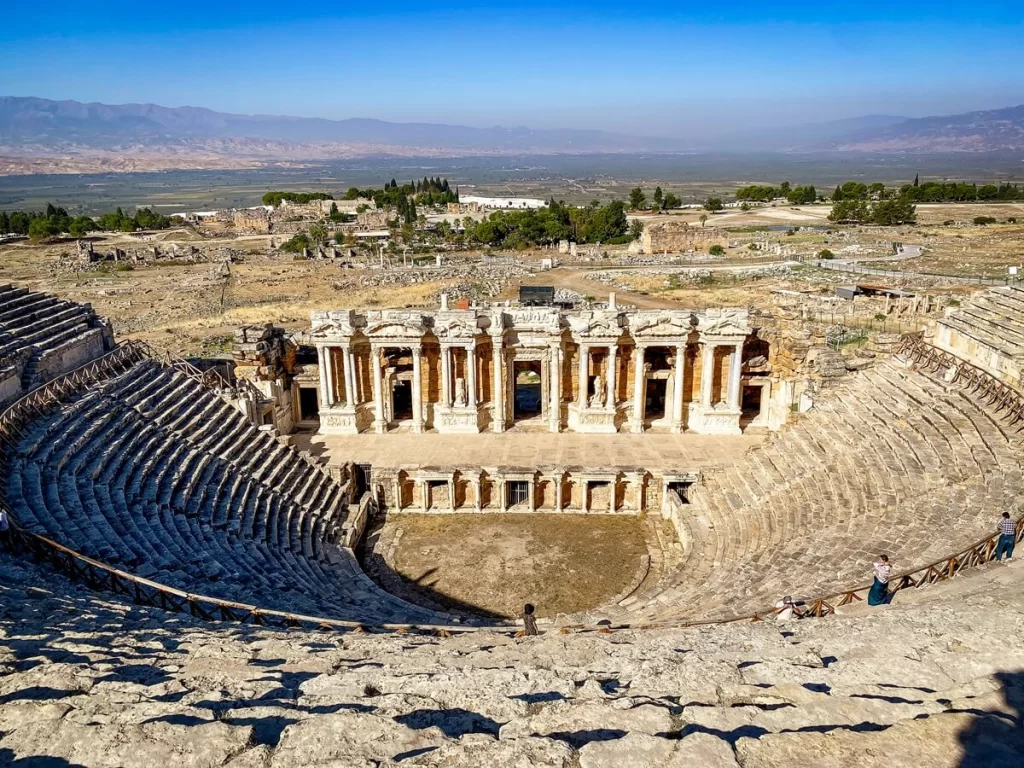
4. Enjoy the Views from the Great Theatre of Hierapolis
Possibly the most impressive structure in the ancient city of Hierapolis is the Great Theatre.
This massive amphitheater was initially constructed in the 2nd century AD, under the Roman Emperor Hadrian. He is well-known for building impressive structures, such as Hadrian’s Wall in the north of England in the UK. Later, during the reign of Emperor Septimius Severus, the theater was renovated. They made plenty of modifications to the scaenae frons (the permanent architectural background of a Roman theatre stage) and the auditorium. Today, it has some of the best preserved decorative features in the country.
It’s worth going all the way to the top to appreciate the scale of this structure. Apparently, the theatre could accommodate over 15,000 people, which is a huge number.
It reminded us of the Great Theatre of Ephesus near Selcuk, which is actually the largest ancient theater in Türkiye. For comparison, that one could accommodate about 24,000 people.
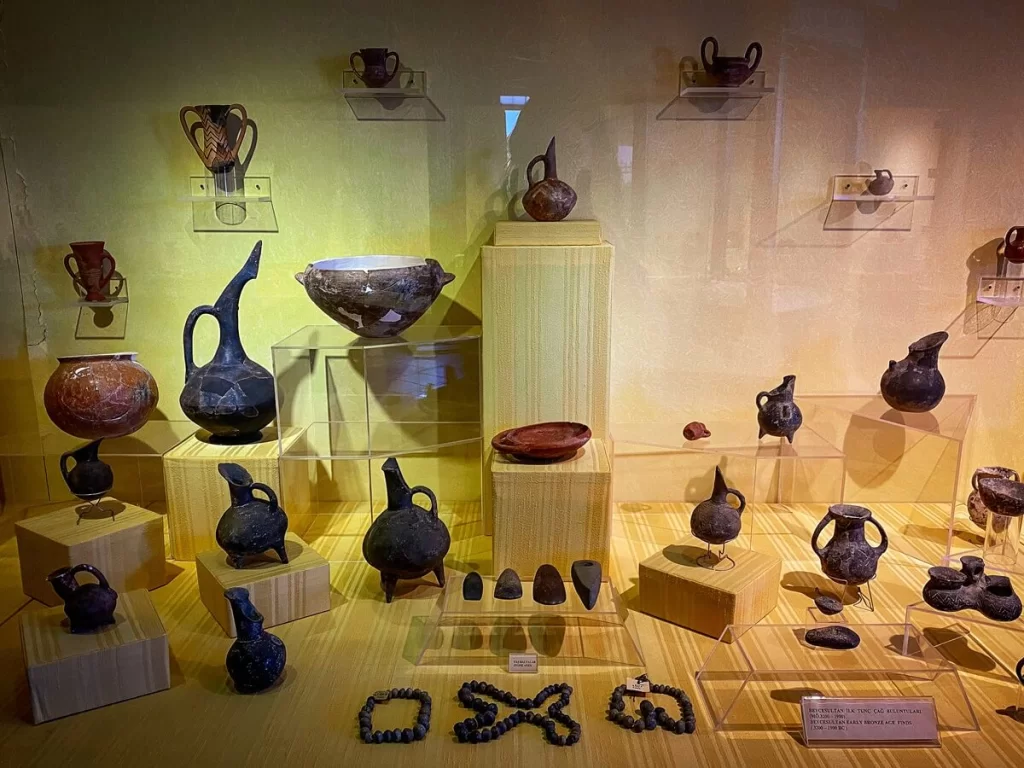

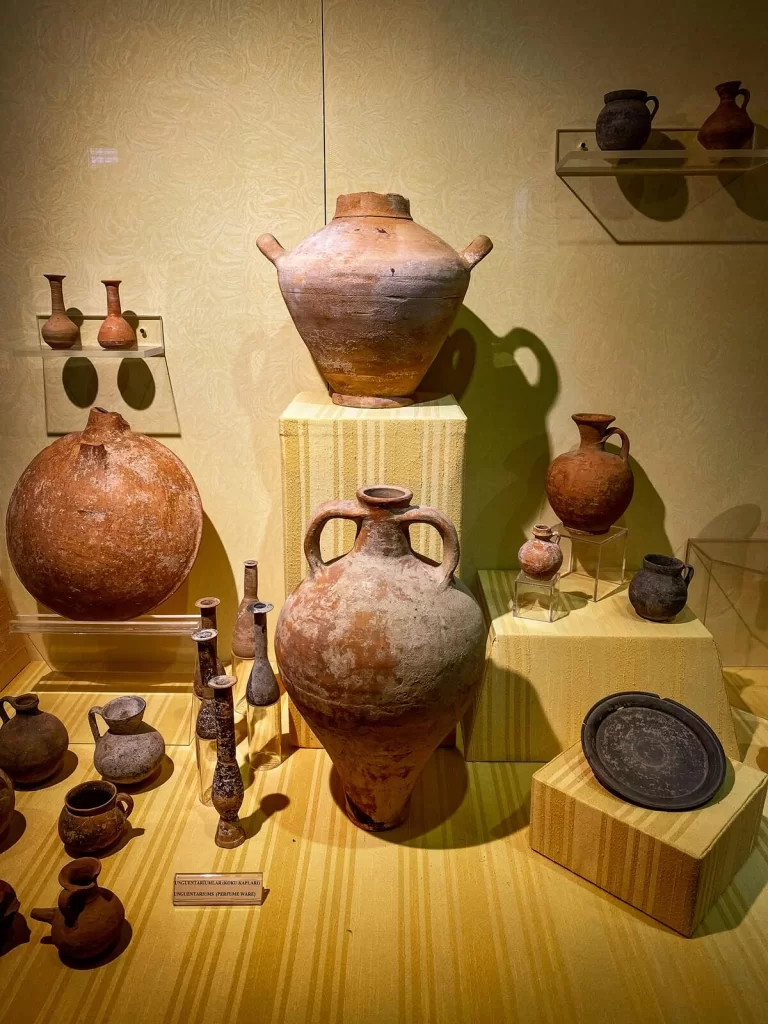
5. Visit the Hierapolis Archaeology Museum
If you want to learn a bit more about the history of the ancient city, then definitely visit the Archaeology Museum.
The museum was first opened to visitors in 1984. Then, restoration works had to be undertaken in 1999 and it was re-opened again in 2000. The museum has three exhibition halls displaying well-preserved artefacts.
The Tombs and Statues Gallery houses objects that were found during the excavations of Hierapolis, Laodiceia and other ruins.
In the Small Artifacts Gallery, you can see smaller items displayed in chronological order from the 4th century BC onwards. Lastly, in the Hierapolis Theater Gallery you’ll find some of the reliefs that once decorated the beautiful stage of the Great Theater.
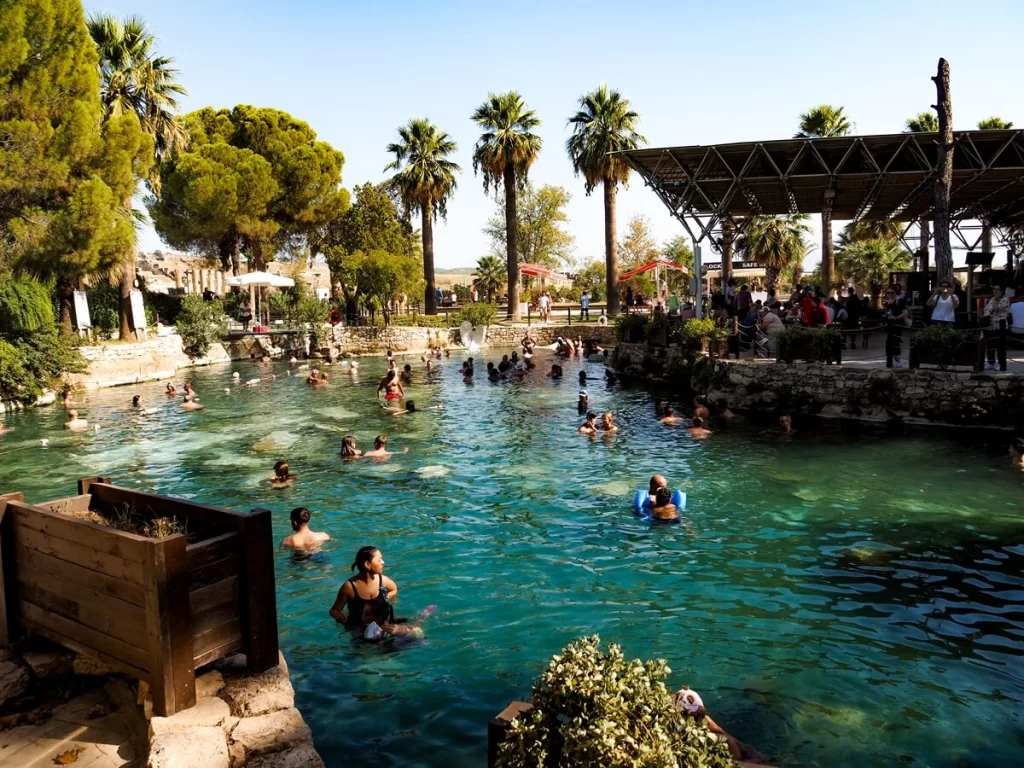
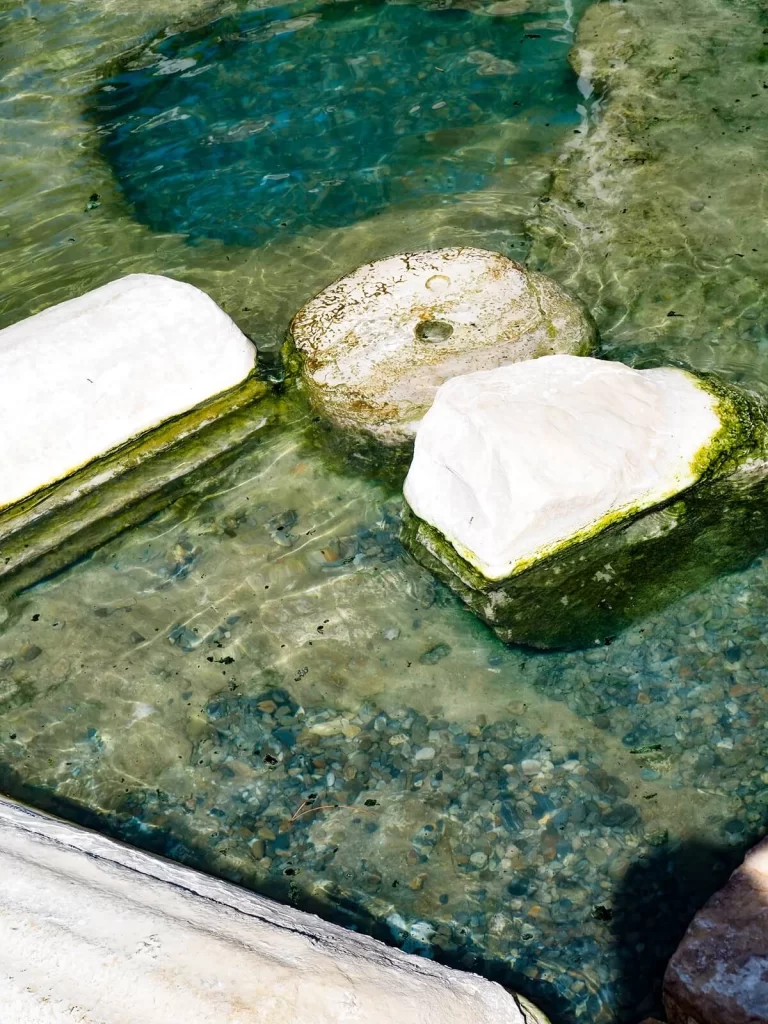
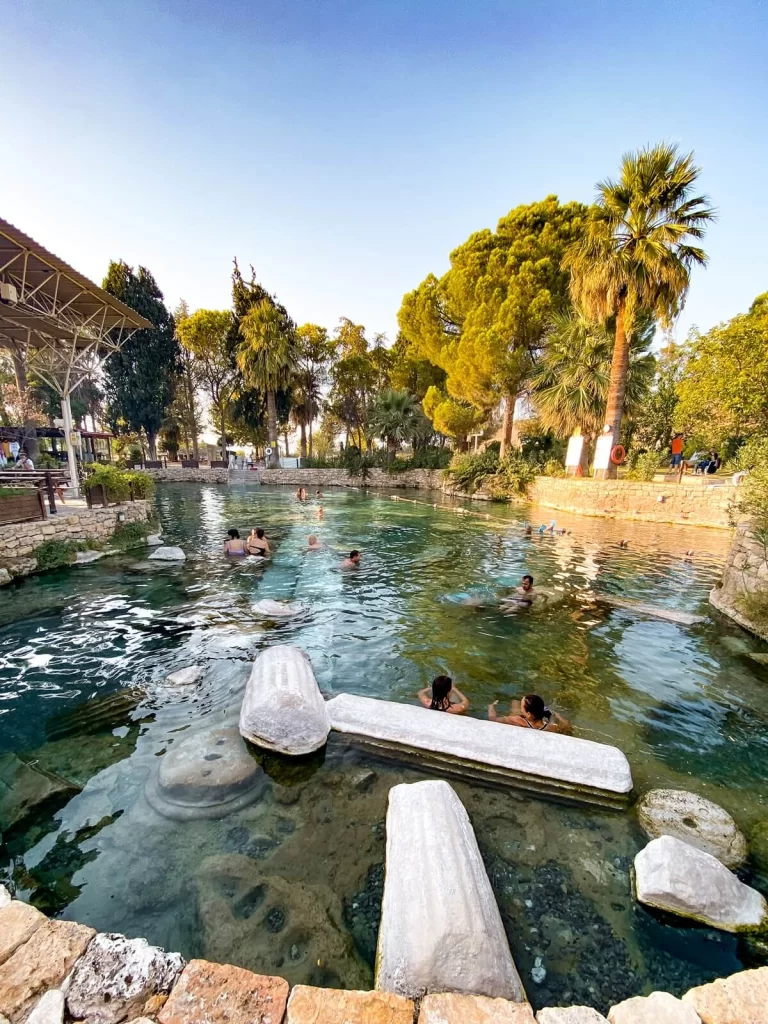
6. Swim in Cleopatra’s Antique Pool
Behind the travertine pools, there’s a man-made bath called Cleopatra’s Antique Pool. It is connected to a natural thermal water source so, apparently, it also has healing properties.
According to legend, the pool was a gift from Marc Anthony to Cleopatra, the Egyptian Queen. Although there’s no proof that she actually visited the pool. It was surmounted by a temple to Apollo, with the roof being held up by Doric columns.
The building got damaged during an earthquake in the 7th century and some of the columns fell into the pool. Today, you can swim around the ruins, which of course attracts a lot of people.
Entry Fee. You’ll have to pay 200 TL (6 EUR) to swim in the pool and a 20 TL (0.60 EUR) deposit for a locker.
Note. You can only take photos from outside the pool, but you cannot take any type of camera with you when you go for a swim. This means that there will be a ton of people standing along the edges taking pictures of each other in the pool. Plus, you won’t be able to take underwater photos of the ruins. It’s a bit of a shame, especially since there’s a cameraman walking around inside the pool, taking photos of tourists for an additional fee. On the flip-side, you don’t need to worry about your camera getting lost or wet in the pool.
Be careful when in the pool, as walking on the ruins can be very slippery. It can also get very busy during peak times, when the large tour groups are around.
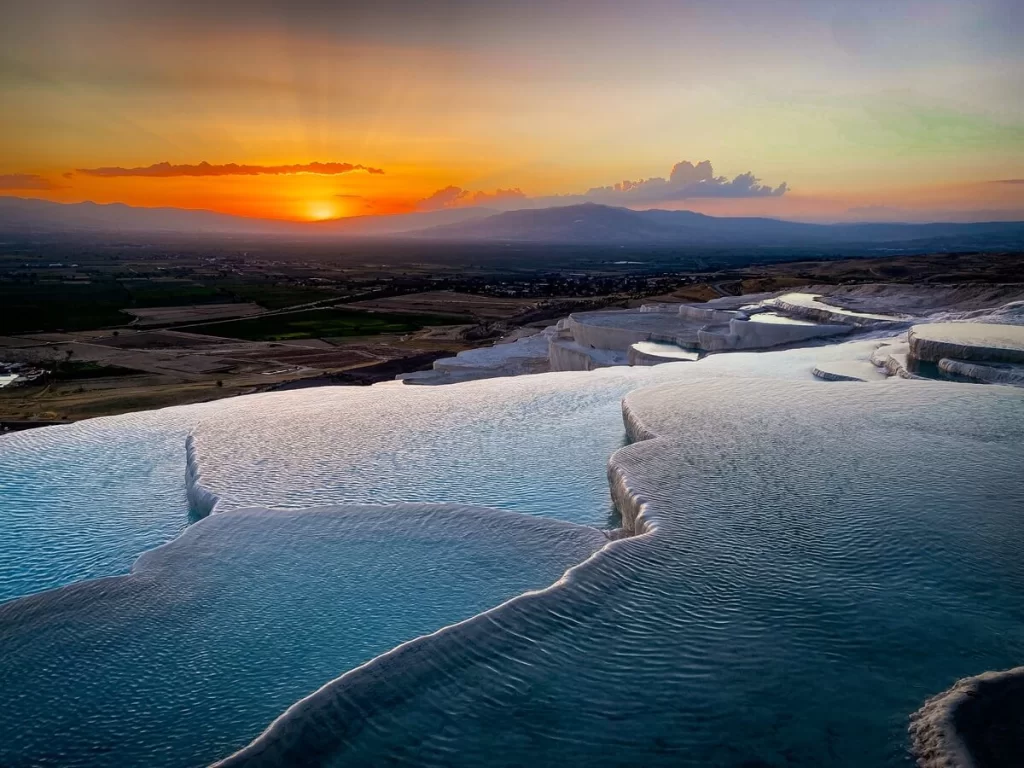
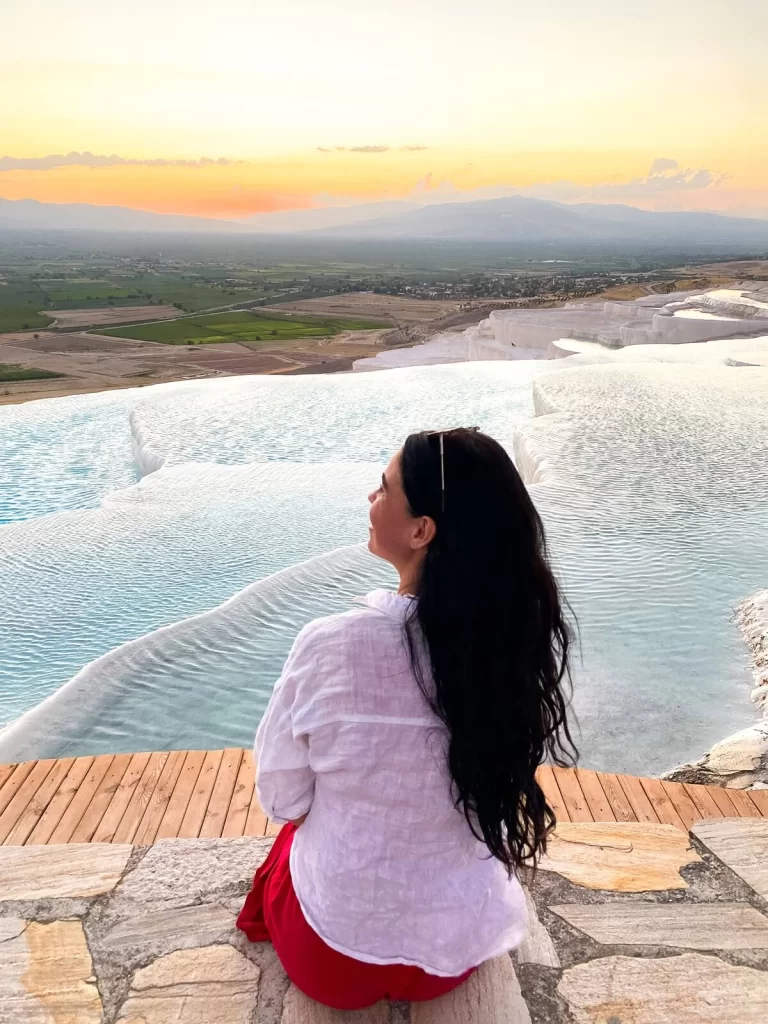
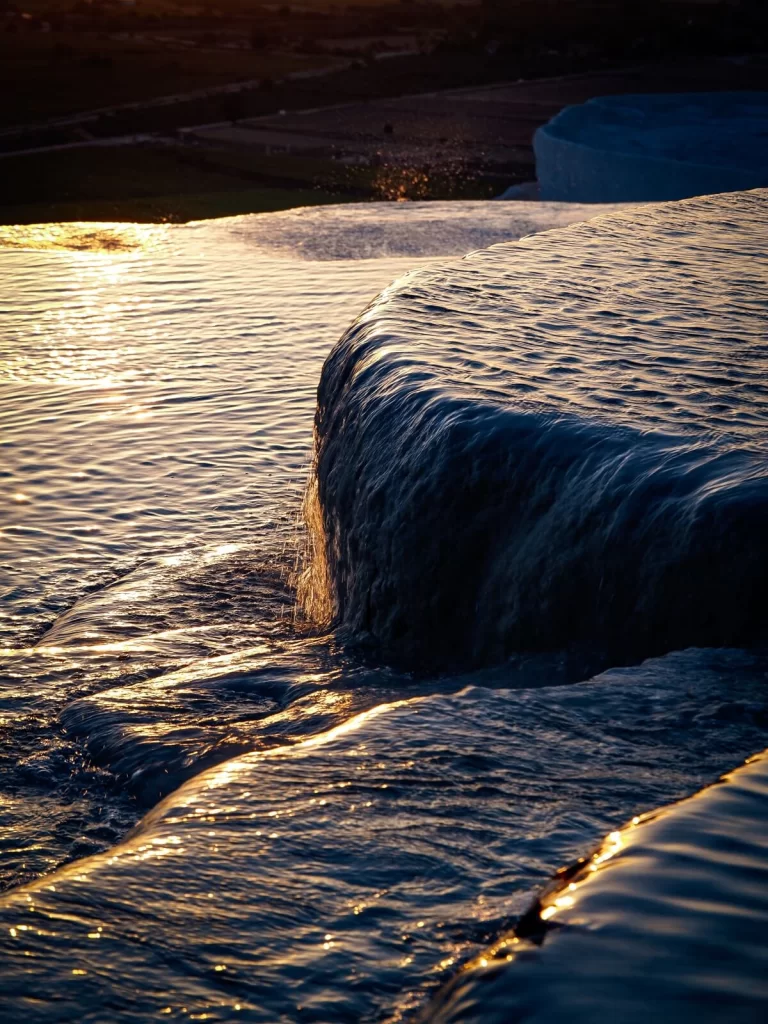
7. Watch the Sunset at the Pamukkale Travertine Pools
A great way to finish your day in Pamukkale is to watch the sunset at the pools. Depending on the sun’s position, you can watch it from either the main pool area, or from the pools located further to the west.
Being able to watch the sunset is one of the benefits of visiting Pamukkale independently. Most day tour groups would’ve left by then, so you’re sharing the experience with way less people.
Don’t forget to linger for a while after the suns dipped behind the horizon. The sky tends to be even nicer after that. You can even stay until it gets a bit darker, to see the town lit up before you leave.
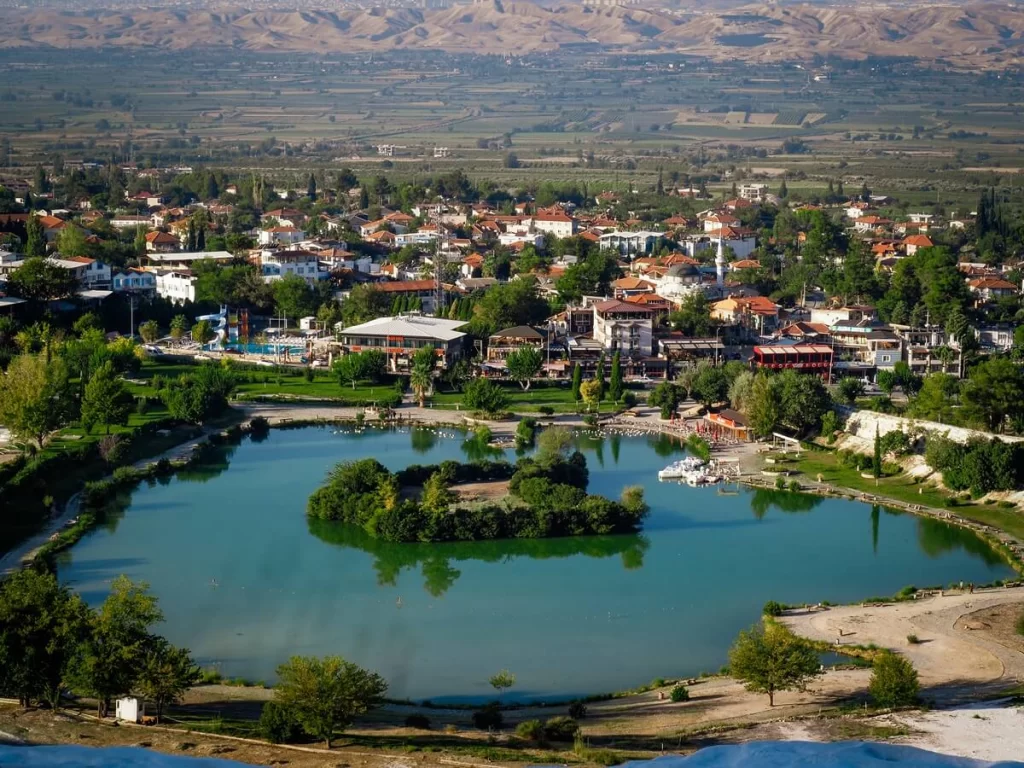
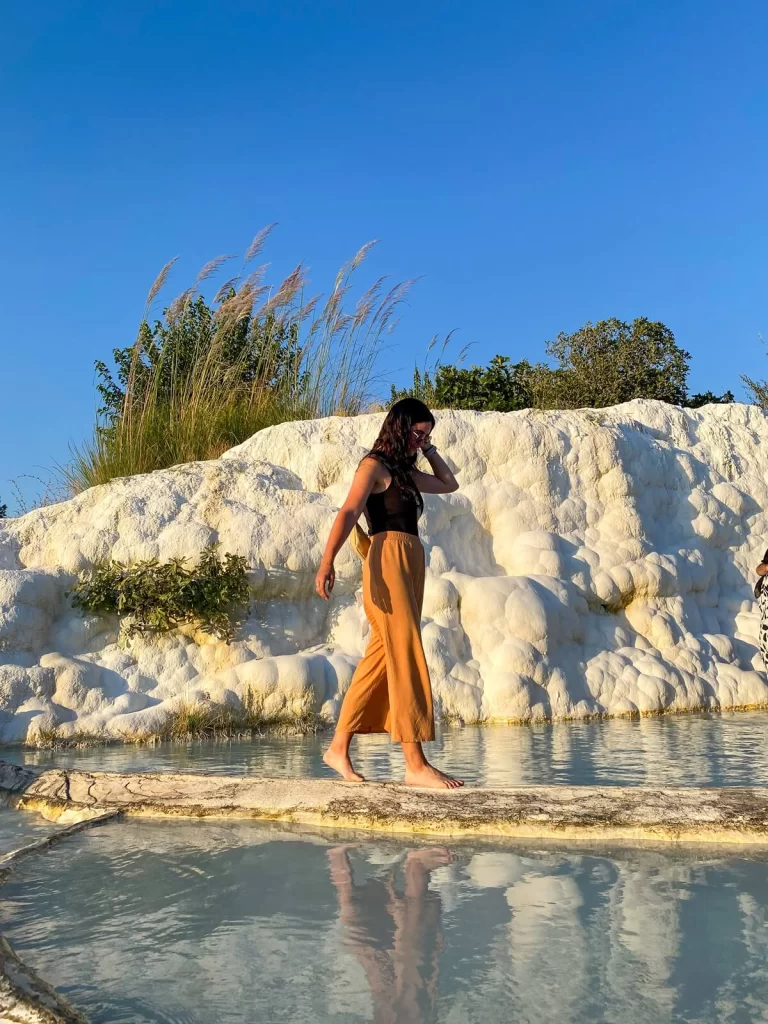
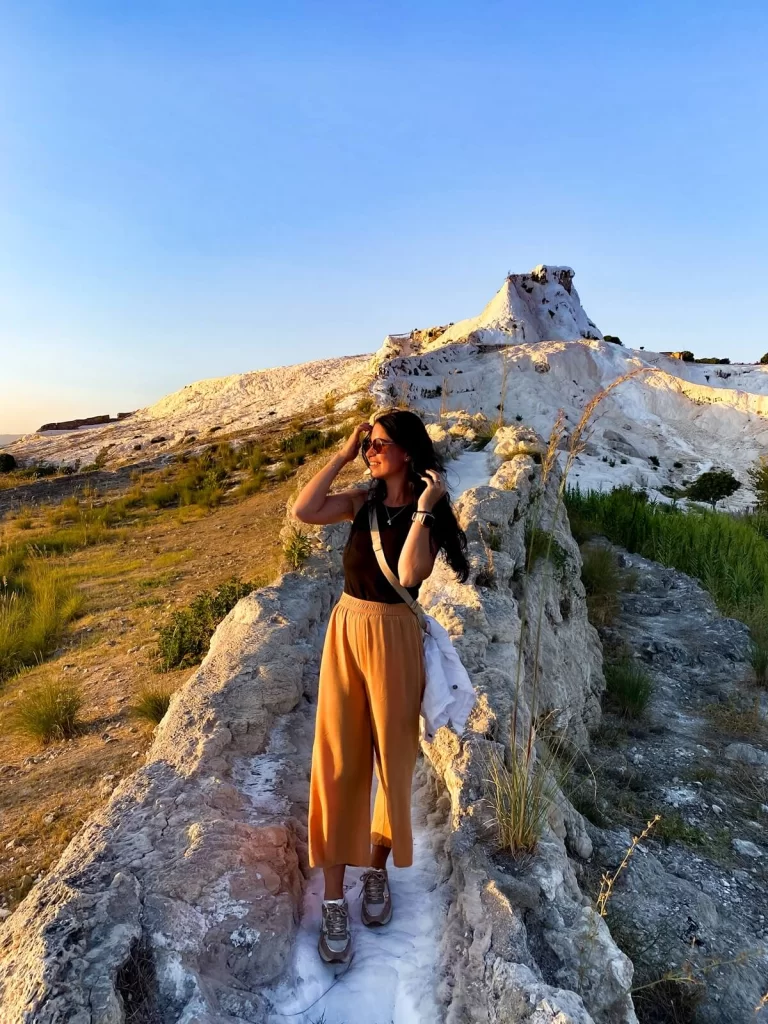
8. Walk Around Pamukkale Park and Garden
Just outside Pamukkale’s entrance in town, you’ll find a small lake and park you can freely walk around. This is a great activity on your first evening after arriving. You can get your first glimpse of the 200m high white cliffs, standing like a small mountain over the town.
There’s even a small pool here you can go into, although it won’t be nearly as impressive as the ones at the top. There are also a lot of restaurants and cafes in the vicinity, where you can enjoy a sit-down meal or a quick bite.
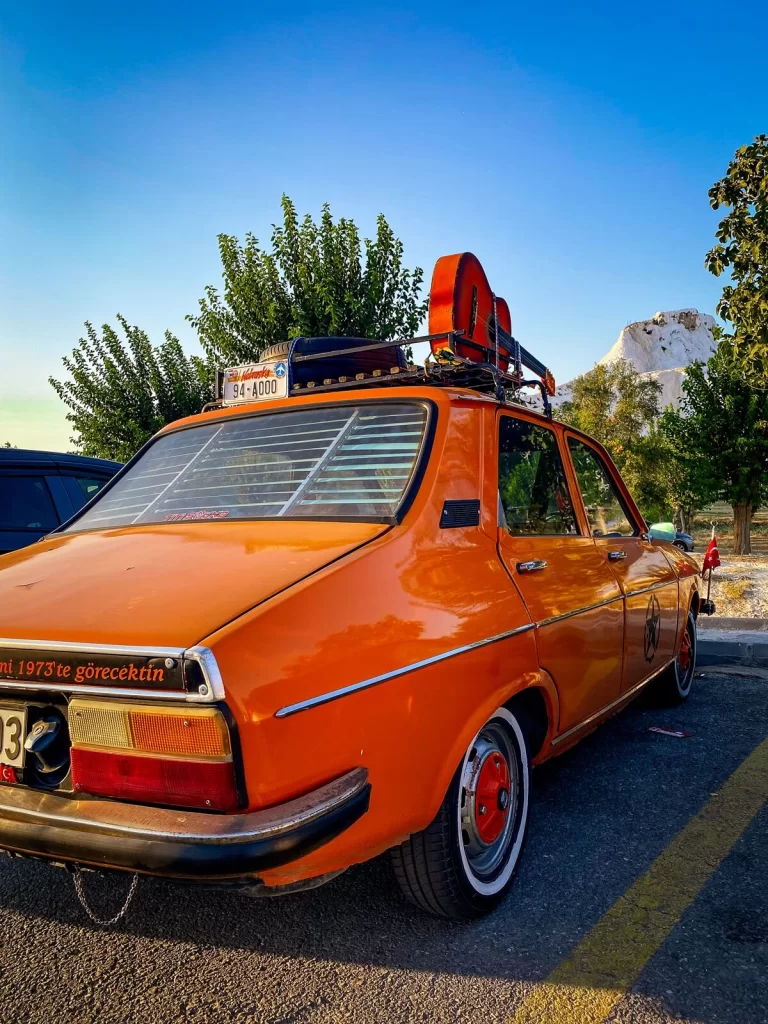

How to Get to Pamukkale from Denizli
There are a few ways to get to Pamukkale, depending on where you’re coming from. The nearest big city is Denizli, which is pretty easy to get to from many popular tourist destinations such as Istanbul, Selcuk, Antalya, Fethiye and Cappadocia. Read our detailed guide on how to get to Denizli from these destinations for more information.
Read Next: How to Get to Pamukkale in Turkey (Türkiye)
Once you’re in Denizli, you can take a minibus (dolmus) from Denizli Otogar, the main bus station. That’s going to be the most affordable way to reach Pamukkale. The minibuses leave regularly from Platform 76, located on the lower level of the terminal. The upper level is for intercity buses, where you’ll most likely arrive to if you’re coming from further afield by bus. The main train station is also just across the road from the bus terminal, so you won’t need to walk too far if arriving by train.
The journey time between Denizli and Pamukkale is about 20 minutes. The minibuses can get a bit crowded, so you might be a bit uncomfortable depending on the time of day you’re travelling.
If you’re flying to Denizli Cardak Airport (DNZ), then you can take a direct shuttle to Pamukkale, or get to Denizli bus terminal and take a minibus from there. Alternatively, you can also take a taxi, but it’ll cost you a lot more.
You can always rent a car and drive around Turkey (Türkiye) if you want to do a more independent road trip.
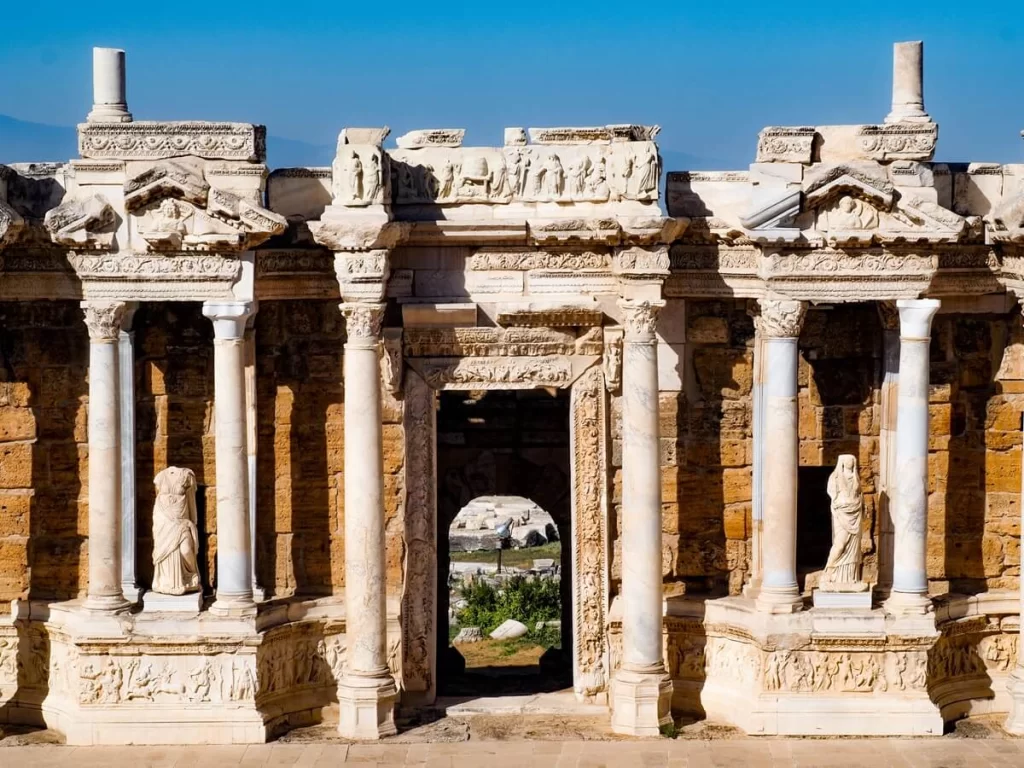
Pamukkale Opening Times and Entry Fee
The site is open every day from 6:30AM until 8PM between April and October. Then in the winter months (between October and April) it’s open from 8AM until 6PM.
The entry fee is 30 EUR which grants you access to the thermal pools, the ancient city of Hierapolis, and the archeology museum. You’ll have to pay an additional 200 TL (6 EUR) if you want to swim in the Cleopatra Antique Pool. However, you can get a discount on this additional entry if you have the Museum Pass.
Top Tip. If you’re staying in Türkiye for longer, then we recommend getting either the Aegean Museum Pass for 95 EUR or the Türkiye Museum Pass for 165 EUR. It might seem like a lot, but when you add up the individual entry fees for the places you want to visit, it might work out cheaper in the end. You can check out what’s included in these passes here.
Note that prices are prone to change so always check the official website for more up-to-date information.
It’s good to know that there are three entrances to Pamukkale:
- Pamukkale Town Entrance is a popular one to enter from if you’re staying somewhere in town. Note that you’ll need to take your shoes off straight away, and walk up the main pool ‘avenue’ to the top.
- Pamukkale South Entrance is the best one if you want to get to the pools earlier than most. This gate opens before the town entrance one does.
- Pamukkale North Entrance is the third gate, that will take you through Hierapolis first.
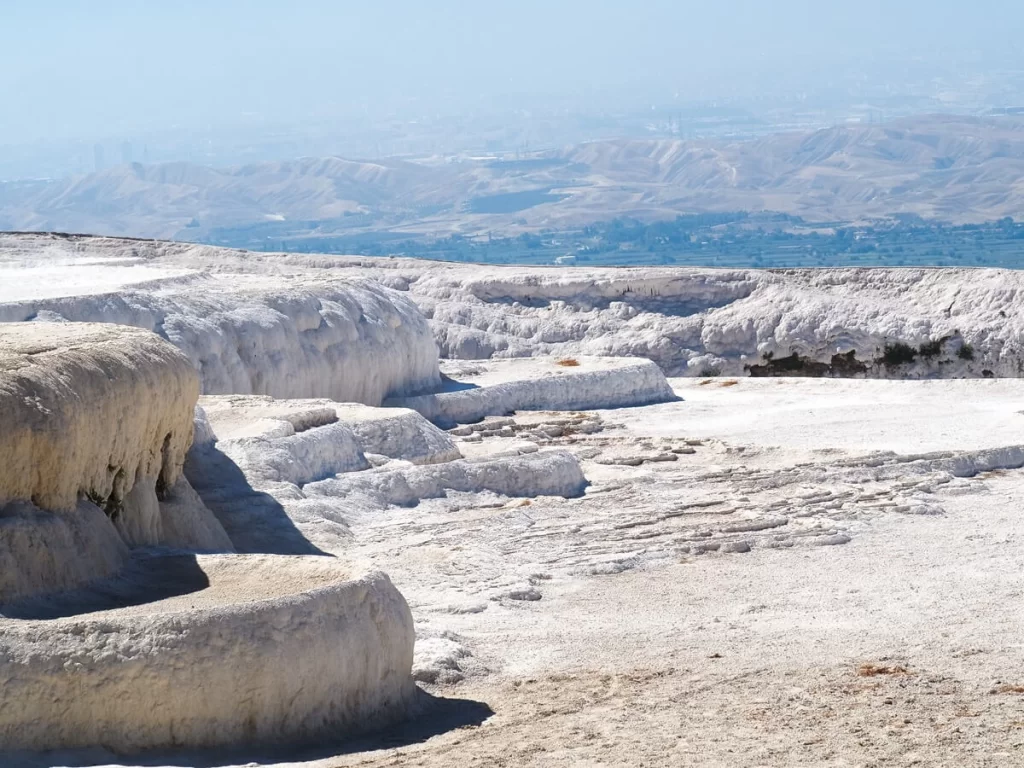
Best Time to Visit Pamukkale
You can visit Pamukkale all year around as the temperatures are always pleasant. The colder months are January and February, whereas the hottest months will be July and August. The latter also coincide with the summer school holidays, which means that the site can get pretty crowded with large tour groups.
If you’d like to have a more pleasant experience, both with the temperature and the crowds, then we recommend visiting in the shoulder season; so either in spring or autumn.
In terms of the best time of day to visit, if you come independently then you should arrive to see the pools at Pamukkale first thing in the morning. The pros of visiting early are that there will be way less people and it won’t be too hot just yet. Every morning you can witness hot air balloons flying around Pamukkale, which offers great photo opportunities. The downside of getting there so early is that the pools, especially the popular ones, might not be filled with water yet. If you want to take those dreamy photos, then you’ll need the pools to be filled with water and have the sun shining on them.
For this reason, it’s also not a bad idea to perhaps walk around Hierapolis first, before it gets too hot. Then, you can come to the pools in the afternoon and for sunset. The crowds should be easing by then, and watching a sunset over the pools is a magical experience.

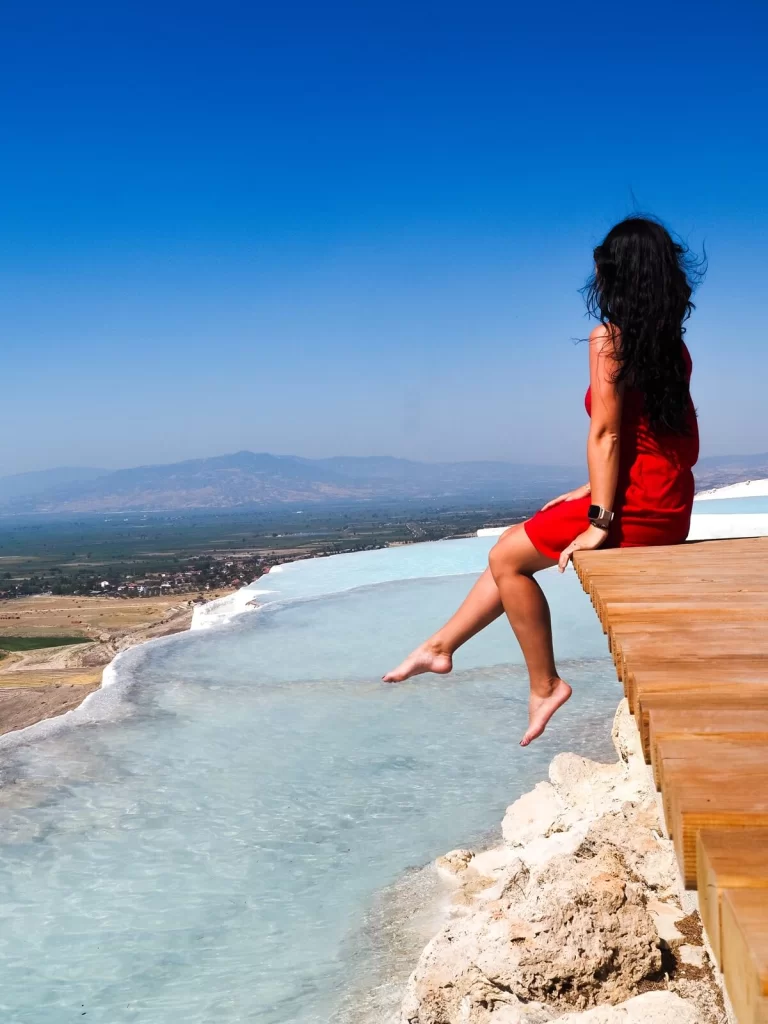
How Long Do You Need in Pamukkale
Because Pamukkale is relatively close to multiple big cities, it’s relatively easy to do as a day trip from places like Antalya and Selcuk.
You can easily see everything in Pamukkale and Hierapolis in just one day, which is why many people opt to visit with a tour. If you’re planning an independent visit, then we recommend booking 2 nights in Pamukkale. That way you can arrive in the afternoon / evening, spend the entire next day at Pamukkale and Hierapolis, and then leave the following morning. If you’re in a hurry, then you can always book for one night, visit Pamukkale the next morning and leave in the afternoon / evening, depending on your transport options.
Pamukkale Guided Tour or Independent Visit
You can visit Pamukkale with or without a tour. If you just want to take a day trip there because you’re on a cruise or just short on time, then we recommend joining a guided tour. That way, you don’t need to worry about your transport and you can also learn more about the site. Some of the most popular places to book a day trip from are Antalya, Kusadasi, Selcuk, Izmir, and Bodrum.
However, you can totally visit Pamukkale and Hierapolis Ancient City on your own. The best way to visit without a guide is to stay at least 1 night (ideally 2 nights) in the town of Pamukkale. From there, you can get to the site for either opening time or later in the afternoon, and enjoy it before the bigger tour groups arrive, or after they’ve already left. Visiting on your own will also allow you to wander around at your own pace, and spend as long or little as you like in certain areas. You can always get the audio guide for Hierapolis, which will allow you to learn more about the site without a physical guide.
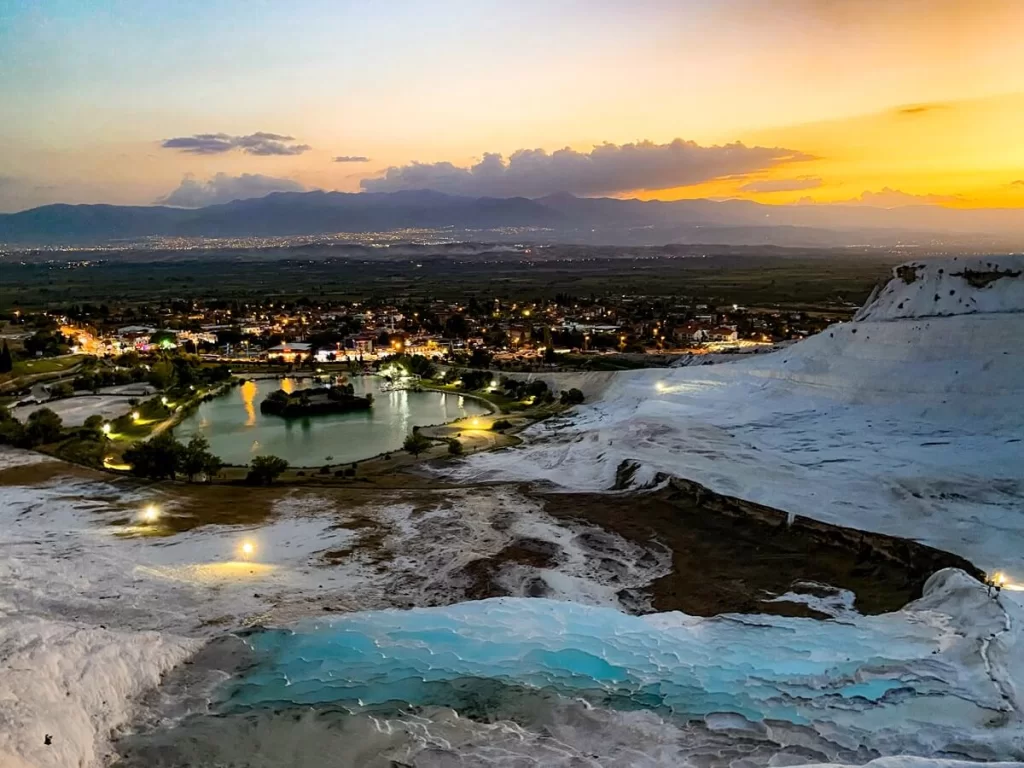
Where to Stay in Pamukkale
If you’d like to make the most of your visit, then we recommend booking your stay in Pamukkale town. There are many places to stay in Pamukkale, but we recommend staying a walkable distance from the entrance to the pools.
Some people do stay in Denizli as well, where you can reach Pamukkale easily as detailed above.
Additional Pamukkale Travel Tips
Below we’ve listed a few useful tips and things to be aware of when visiting Pamukkale and Hierapolis:
- You’ll have to take your shoes off when walking on the travertine pools. It’s mostly very grippy but some areas can be slippery, and it’s a bit painful to walk on.
- Be careful walking near the edge because it can be slippery.
- Only walk on the travertine pools where you’re allowed to! There are clear signs in many areas telling you that you can’t walk out onto the pools. As always, we saw plenty of people ignoring these signs. Please don’t be one of them! Let’s protect Mother Nature’s beautiful creation.
- Wear comfortable shoes. Whilst you have to go barefoot around the pools, it’s important to have comfortable shoes on when walking around Hierapolis.
- Bring swimwear and towels if you want to swim in Cleopatra’s pool.
- You can’t take your camera into Cleopatra’s pool. They really check it closely, so it’s best to ask someone who isn’t in the pool to take a photo of you. It also stops you from taking a photo of the ruins under the water unfortunately. There are photographers though, ready to take photos of you for an extra cost.
- Make sure to wear sufficient sun protection such as reef-safe SPF, sunglasses, and a hat.
- Bring enough water for the day. There are places to purchase food and drinks, but the prices are way higher than in town.
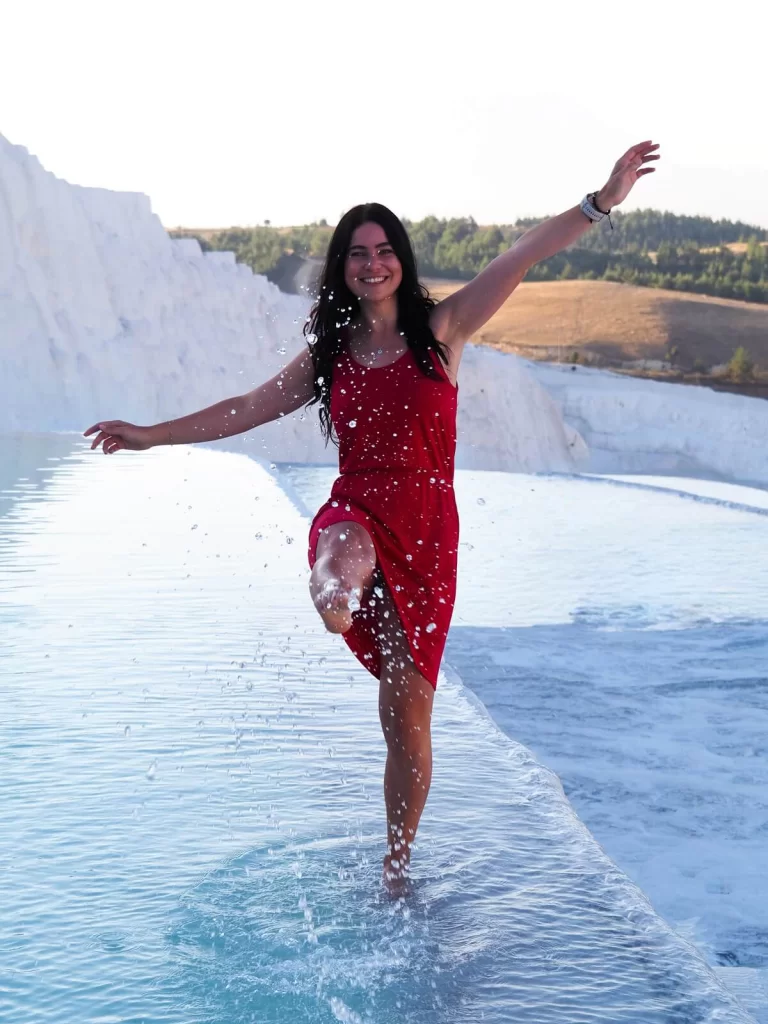
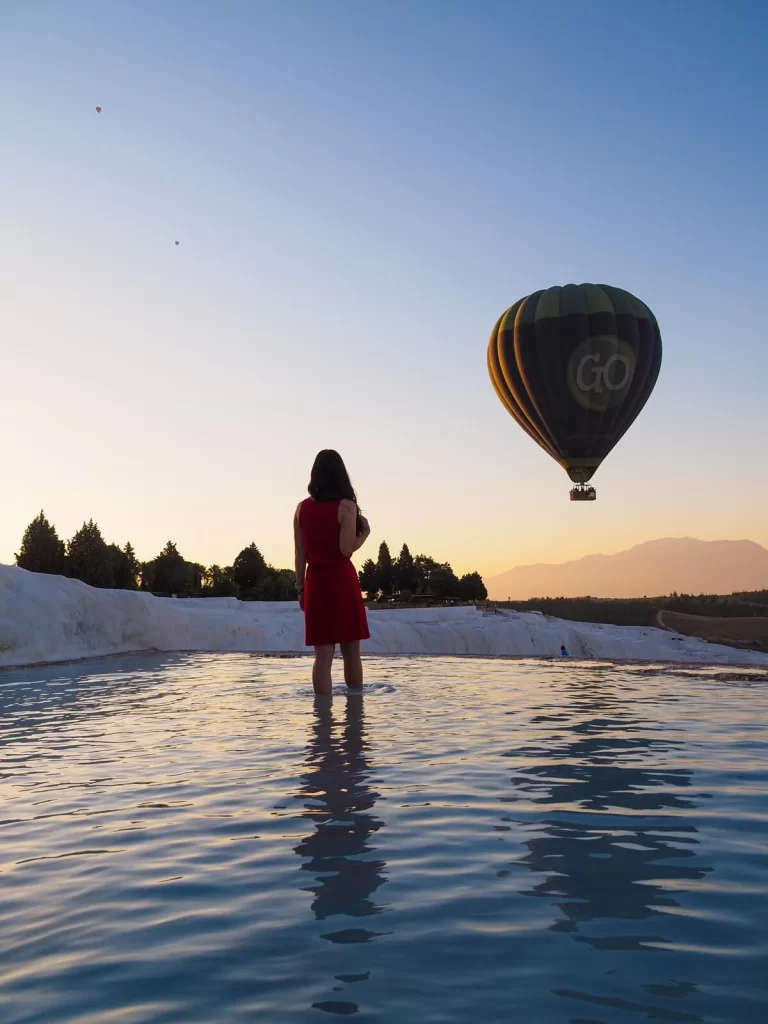
Final Thoughts on One Day in Pamukkale and Hierapolis
Pamukkale is definitely one of the most visited places in the country. In order to avoid the crowds as much as possible, we stayed in Pamukkale town for 2 nights. From there, we could get to the entrance for opening time and watch the sunrise with the hot air balloons. Then we spent the entire day there exploring every corner of the site. The best part of spending the whole day there was being able to catch the sunset too, and having some more peaceful moments on either side of the large tour groups. Of course, the downside is that you’re on your feet all day and there’s hardly anywhere to escape the heat. Food and drink prices are also way more inflated within the site than outside.
Overall, we were happy that we stayed there all day, and will never forget the incredible sunset we witnessed.
Have you ever been to Pamukkale before? If so, did you visit independently or with a tour? How was your experience? If not, would you spend an entire day at the site like we did? Let us know in the comments below.
Now, let your adventure begin,

Our Top Travel Resources
Accommodation: For hotels we always use Booking.com and Hostelworld for hostels. We also book longer stays on Airbnb or Vrbo.
Flights: To find the best flight prices we always check Skyscanner, Google Flights or WayAway. Then we also check the airlines’ websites too for comparison.
Car Rentals: We use Discover Cars when we want to rent a car as it compares local, national and international companies.
Activities: If we book organised tours we always check either GetYourGuide or Viator.
Foreign Currency: Whenever we can we prefer to pay in local currency and for that we always use our Wise card. We can easily withdraw money from the ATM or pay by card at most shops and restaurants.
Travel Insurance: We never go anywhere without travel insurance. You never know what will happen on your trip, so good travel insurance like SafetyWing can protect you in case of injury, illness, theft and cancellations.
eSIM and VPN: To get data abroad we use Airalo which is an app that allows you to download a prepaid eSIM to your phone in over 190 countries. Make sure to have a VPN to avoid hackers accessing your personal data when using public WIFI. We use Surfshark which is the only VPN that offers one account on unlimited devices.

